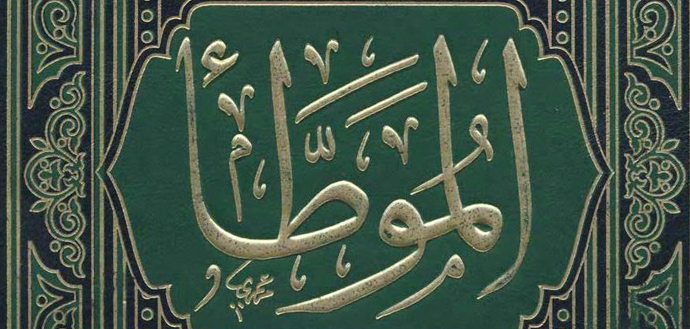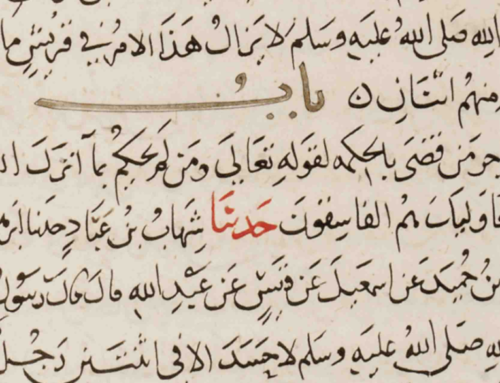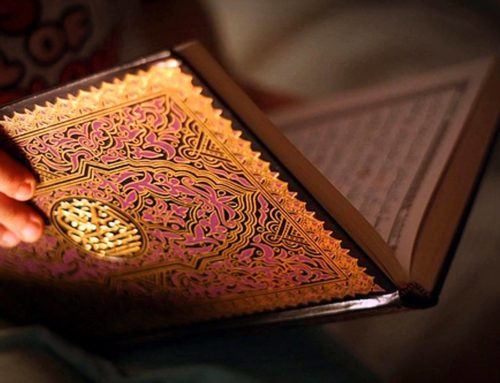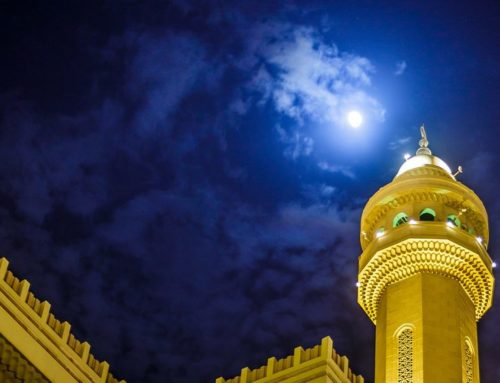Taken with permission from the English translation of Hujjat Allah al-Balighah by Prof. Marcia K. Hermansen.
Be informed that there it no way for us to [obtain] knowledge of the divine laws and the rulings except through the report of the Prophet (Allah bless him and give him peace), in contrast to the case of the beneficial purposes, for these may be understood through experience, true reflection, surmisal, and so on. There is also no way for us to have knowledge of the sayings of the Prophet (Allah bless him and give him peace) except by receiving reports which go back to him by successive links and transmission, whether they are in his words; or they are interrupted hadiths (mawquf) whose transmission was verified by a group of the Companions and the Successors, in so far as they were remote from taking the initiative to decide on something like that if there were not a proof text or sign from the law-giver. An example of this is transmitting an indication (dalalah) from him. [1]Dalalah or indication, in the Islamic theory of signification refers to how an utterance may signify though various modes and logical implications.
In our time there is no way to receive these reports except to follow the literature written in the science of hadith, for today there is not to be found any report which is reliable unless it is written down. The books about hadith are of different ranks and at various levels and it is necessary to exercise care in recognizing their ranks.
We hold that these collections are of four ranks with respect to accuracy and repute.
[1] This is because the highest types of hadiths, as you learned in what preceded – are those confirmed from the beginning by many reports (tawtur), and the community agreed to accept them and to act on them.
[2] Next are those which are well known and transmitted abundantly through numerous lines (mustafid). There remains no doubt worth considering regarding them, and the majority of the legal scholars of the garrison towns [2]The Garrison towns (amsar) where the early Muslims settled in the populated areas of Syria and Iraq and scholarship and legal schools developed in the second and third Islamic centuries. agreed on them, and in particular the learned scholars of the two sacred cities did not disagree with them, for Makkah and Madinah were the location of the rightly-guided caliphs in the first generations and were frequented by the itinerant learned scholars generation after generation, so that it was unlikely that an obvious error would be accepted by them, or that it would become well-known and implemented within a large area and be reported by a large body of the Companions and the Successors.
[3] The third group of hadith are the ones whose chain of reporters is sound or good, and is testified to by the scholars of the hadith, and they are not abandoned sayings which no one of the community holds to be true.
[4] As for [the fourth group which are] weak, invented (mawdu’), interrupted in chain, or transposed (maqlub) in text, transmitted from unknown persons, or opposed to [a hadith] which the pious ancestors agreed on generation after generation; there is no way to uphold them. Thus, the accuracy resides in the compiler of the book having made a condition for himself the citing of what is sound and good, not transposed, anomalous (shadh) [3]A report from a single authority which differs from what others report. or weak, unless he provides an accompanying explanation of its status; for citing the weak hadith together with an explanation of its status would not detract from the book…
Investigation has established that only three books belong to the first rank:
[1] The Muwatta, the Sahih of Al-Bukhari, and the Sahih Muslim. Al-Shafi’i said, “The most sound book after the book of Allah is the Muwatta of Malik.” And the experts in hadith studies agreed that everything in it is sound (sahih) according to Malik’s opinion and those who concurred with him. As for the opinion of other hadith scholars, no hadith interrupted just before reaching the Prophet (Allah bless him and give him peace) and no interrupted hadith (munqati’) was included in it unless its chain went back directly to the Prophet (Allah bless him and give him peace) through some other line, so that it is definitely sound due to this reason. In the time of Malik many Muwatta’s were written in which Malik’s hadiths were investigated and classified and their interrupted chains were taken directly back to the Prophet (Allah bless him and give him peace) such as the books of Ibn Abi Dhi’b, lbn ‘Uyaynah, Al-Thawri and Mu’ammar and others who shared the same teachers with Malik…
As for the two Sahih’s [of Muslim and Al-Bukhari], the hadith scholars agreed that all of the uninterrupted hadiths going back to the Prophet (Allah bless him and give him peace) in them are certainly sound, and that the [contents of] the two books reached their compilers in multiply-transmitted connected chains, and that whoever holds them in contempt is an innovator in religion who is not following the path of the believers…
[2] The second rank of books are books which don’t attain the rank of the Muwatta and the two Sahih’s but which are next after them. Their authors were well known for their reliability, integrity, memory and being deeply immersed in the laws of hadith, and in their books they were not satisfied to be lax about whatever they had set as conditions for themselves. Therefore those after them accepted these books as sound, and the hadith scholars and legal experts paid attention to them, generation after generation, and these books achieved a reputation among people. Some people were devoted to explaining their unusual (gharib) hadiths, investigating the transmitters, and making inferences about their juristic significance, and upon these hadiths are based the general hadith sciences.
They include the Sunan of Abu Dawud and the Jam’i of Al-Tirmidhi and Al-Mujtaba of Al-Nasa’i. The hadiths of these books together with those of the first rank, are given attention by Razin in Tajrid al-Sihah and Ibn al-Athir in Jam’i al-‘Usul, and the Musnad of Ahmad [ibn Hanbal] is generally included in this rank, for Imam Ahmad made [his book] a basis for discerning the sound and the faulty saying, ‘Don’t accept what is not in it [my book].”
[3] The third rank [4]Imam Shah ‘Abd al-‘Aziz Dahlawi (may Allah have mercy on him) writes, “Third Category: It includes traditions which were narrated by the ‘ulama preceding Imam Bukhari and Imam … Continue reading is comprised of those Musnad, Jami’, and Musannaf works compiled before Al-Bukhari and Muslim, during their time, and after them which combine the sound, the good, the weak, and the recognized (ma’ruf) and the uncommon; the anomalous and the objectionable (munkar) the erroneous and the correct; and the continued and the transposed. They do not have the same reputation among the learned scholars, even if they are not given the designation of “absolute rejection”. The learned religious scholars have not given much currency to those hadiths found uniquely in these works, and the hadith scholars have not carried out major investigations into their soundness or faultiness. Among these books are the ones for which no linguist has rendered the service of explaining its rate expressions, nor has any legal scholar worked to reconcile it with the opinions of the pious ancestors, nor has any hadith scholar explained its problematic (mushkil) hadiths nor has any historian made mention of its transmitters. I do not refer to those recent authors who are hair splitters; rather I am speaking of the early leaders (imams) of the hadith scholars.
Therefore their books have remained obscure, unknown, and undistinguished, such as the Musnad of Abu ‘Ali, the Musannaf of ‘Abd al-Razzaq, the Musannaf of Abu Bakr ibn Abi Shaybah, the Musnad of ‘Abd ibn Humayd, Al-Tayalisi, and the books of Al-Bayhaqi, Al-Tahawi and Al-Tabrani. The goal of these authors was to collect whatever they found, not to extract the best, nor to refine them, nor to make them more accessible for use.
[4] The fourth rank [5]Imam Shah ‘Abd al-‘Aziz Dahlawi writes, “Fourth Category: It includes the traditions which are not traced in the early periods while they are narrated by the later ones. So, such … Continue reading are those whose authors after long centuries sought to gather hadiths which were not found in the first and second ranks of books, and these were in obscure Jami’ and Musnad works, then they brought them to light. These had been transmitted from those whose reports the hadith scholars did not record, such as many of the jabbering preachers, heretics, and unreliable persons, or they were traditions (athar) of the Companions and the Successors, or reports of the Children of Israel, or from the philosophers and preachers, which were mixed by other transmitters with hadiths of the Prophet (Allah bless him and give him peace) mistakenly or deliberately. Or they were interpretations of the Qur’an or the sound hadiths, so that a group of righteous people transmitted their sense not realizing the abstruseness of the science of transmission, and therefore they made these ideas into hadith going back to the Prophet. Or these were concepts understood from the indications of the Qur’an and the Sunnah which they deliberately made into completely independent hadiths or there might have existed an assorted group of various hadiths which they combined into one hadith as a uniform narration.
The place to find such hadiths is the Kitab al-Du’afa’ (The Book of the Unreliable Hadiths) of Ibn Hibban, Al-Kamil of Ibn ‘Adi and the books of Al-Khatib, Abu Nu’aym, Al-Jawzqani, Ibn ‘Asakir, Ibn al Najjar, and Al-Daylami, and the Musnad of Al-Khawarzimi is almost of this rank. The best of this rank are those which are weak but equivocal, and the worst are those which are fabricated and whose word order is transposed and which merit the strongest denial. This rank is the subject of the book Al-Mawdu’at (The Fabrications) of Ibn al-Jawzi.
[5] There is also a fifth rank including what is widespread among the legal scholars, the Sufis, the historians and so on, and it has no basis in these four ranks. This includes the interpolations of those insolent about their religion, who know its language and invent strong chains which cannot be invalidated, and eloquent sayings which seem to issue from the Prophet (Allah bless him and give him peace) and thus they have provoked in Islam a great misfortune. However the brilliant minds among the People of the Hadith have adduced things like this on this basis of the recensions and the context in which these are used and they have torn away the veils and exposed the flaws.
As for the first and second ranks, it is upon them that the hadith scholars rely, and it is within the sanctuary of these two ranks that their grazing ground and pasture lies. As for the third rank, no one undertakes implementing them and holding them to be accurate except the rare brilliant ones who have memorized the names of the transmitters and the defects [in the isnads] of the hadith, although indeed sometimes supporting evidence for the text or meaning of other hadiths can be taken from these. “God made for everything a measure”. (Qur’an, 65:3)
As for the fourth rank, being preoccupied with collecting them or deriving from them is a sort of hair-splitting of the latter day writers. If you want the truth, sects of innovators among the Rawafid, and the Mu’tazilah and the others were capable, with the least effort, to extract from these evidence for their points of view. However, referring to such hadiths for assistance during the disputations of the scholars of hadith is not correct, and God knows better.
Hujjat Allah al-Balighah (The Conclusive argument from God), p.387-395.
| ↑1 | Dalalah or indication, in the Islamic theory of signification refers to how an utterance may signify though various modes and logical implications. |
|---|---|
| ↑2 | The Garrison towns (amsar) where the early Muslims settled in the populated areas of Syria and Iraq and scholarship and legal schools developed in the second and third Islamic centuries. |
| ↑3 | A report from a single authority which differs from what others report. |
| ↑4 | Imam Shah ‘Abd al-‘Aziz Dahlawi (may Allah have mercy on him) writes, “Third Category: It includes traditions which were narrated by the ‘ulama preceding Imam Bukhari and Imam Muslim, or their contemporaries or those who followed them in their books, but they did not strictly adhere to narrate only authentic (sahih) traditions. Their books are not as popular and acceptable as those mentioned in the first and second categories, though the authors of these books were well qualified in hadith and were amply trustworthy, fair and brilliant. These books contain all types of hadiths like sahih, hasan, dh’aif (weak) and even mawdu’ (fabricated) traditions, while some of the narrators of these books are fair ones; some are mastur (hidden) while some are majhul (unknown). And most of the hadiths of these books are not practicable according to the Fiqh scholars, even some [hadiths in these books] go against what is unanimously agreed upon. However, these books, in themselves, are of different ranks, some are better than others. These books are as follows: Musnad Shafi’i, Sunan Ibn Majah, Musnad Darimi, Musnad Abu Ya’la Mawsili, Musannaf ‘Abd al-Razzaq, Musannaf Abu Bakr ibn Abi Shaybah, Musnad ‘Abd bin Humayd, Musnad Abu Dawud Tayalisi, Sunan Daruqutni, Sahih Ibn Hibban, Mustadrak Hakim, the books of Bayhaqi, the books of Al-Tahawi and books of Al-Tabrani. (‘Ujalah Nafi’ah, p.8) — Translation by Muhammadullah Khalili Qasmi |
| ↑5 | Imam Shah ‘Abd al-‘Aziz Dahlawi writes, “Fourth Category: It includes the traditions which are not traced in the early periods while they are narrated by the later ones. So, such traditions must not be free of any of the two things; either the earlier ‘ulama investigated them and did not find them original and turned them down, or they found these traditions but with some fault and defect, so they left them. And in both the cases, these traditions are not reliable and they cannot be taken as to support any belief or practice. What a good saying is this about such traditions:
If you do not know, it is a problem, These type of hadiths were dealt by many muhaddithin and due to multiple chains of such hadiths available in the books of this category, they mistakenly regarded them as mutawatir and made them as proof of certain matters in opposition to the traditions of the first, second and third categories. |







Subhanallah. Truly no one like the Shah was ever born in India.
Jazakallahu Khairan Azeema, Very Informative.
Alhamdulillahu, wAllahu Akbar, May Allah be pleased with him.